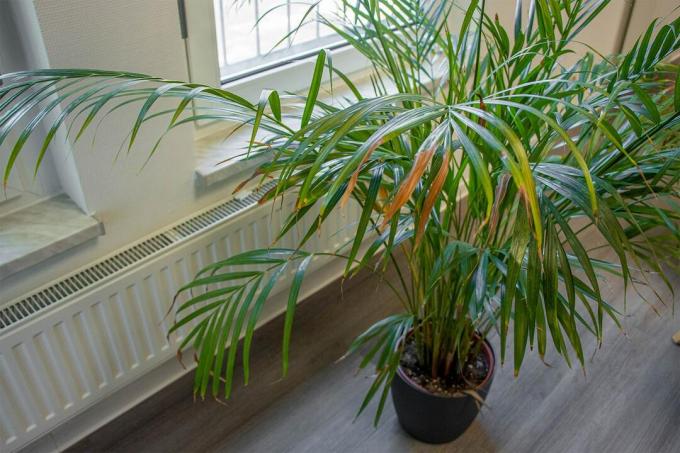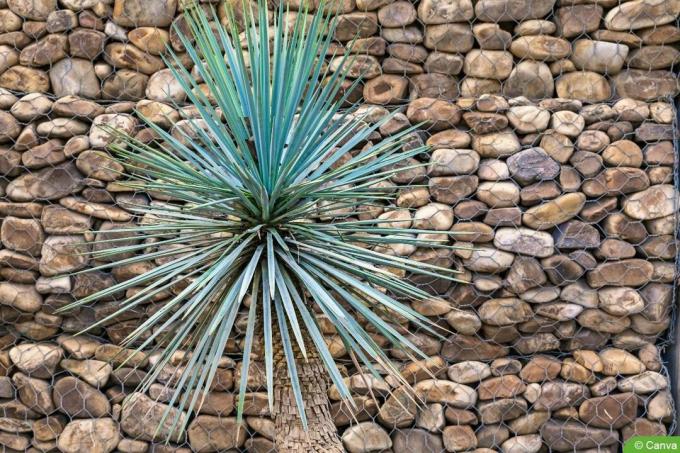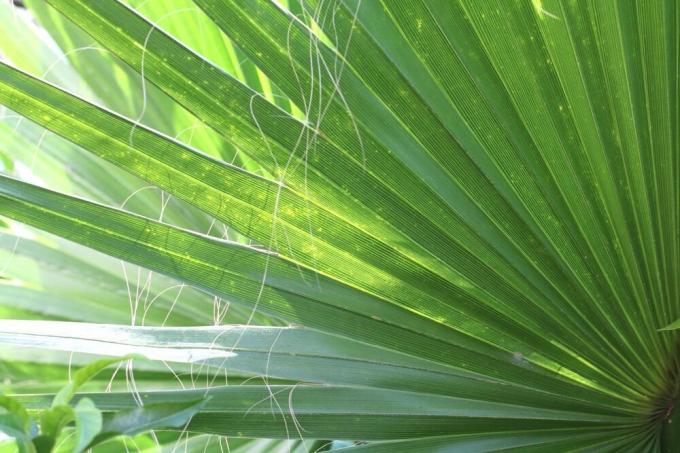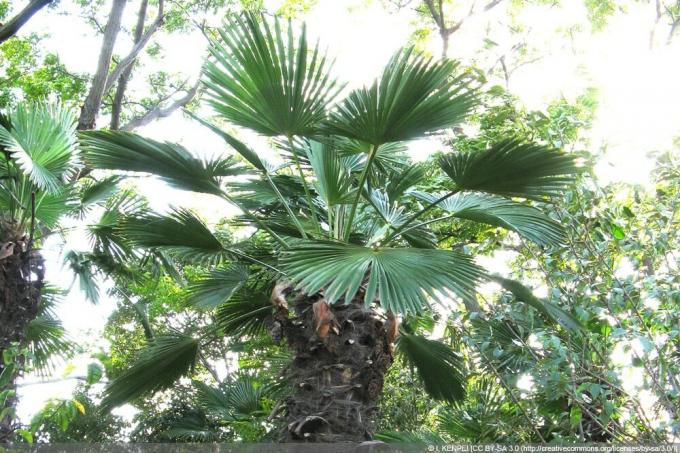

Table of contents
- lack of light
- dryness
- waterlogging
- sunburn
- Faulty hibernation
- nutrient deficiency
- excess lime
- Fungal infections, such as leaf spot disease or others
- spider mites
- Conclusion
The yucca palm is considered a guarantee for easy-care room greening that requires little attention. However, the evergreen plant with the palm-like silhouette only lives up to this image if the premises for professional cultivation are met. The light and temperature conditions at the location are just as relevant as balanced watering and fertilizing. Where the basic conditions are not right, the palm lily presents itself with yellow leaves and brown tips. In order to uncover the trigger for the damage, you cannot avoid a detailed analysis. We have compiled common causes with suggestions for a solution for you here.
lack of light
Solution: Relocate to a bright location
The majority of yucca species are native to the sun-drenched regions of Mexico. Their shapely sword blades only keep their rich green color when they stay in a bright, sunny spot. A yucca palm should be exposed to the sun at least in the morning or evening hours. Where this is not the case, the leaves turn yellow during the dark season at the latest. Therefore, put the lighting conditions to the test and, if in doubt, move the sun-loving plant to a place at the south, west or east window, with shading when the sun is blazing lunchtime.
dryness
Solution: Dip and from now on pour by finger test
In order for a yucca palm to meet expectations as the dominant indoor plant, a balanced water balance sets the course. If the evergreen plant suffers from a lack of water, this results in growth depression, during which the tips of the leaves turn brown. If the drought continues, all foliage will die off. As an immediate measure, the root ball is dipped. That is how it goes:
- Dip the dried root ball in a bucket of lime-free water
- Soak until no more air bubbles rise
- Allow the water to drain well before placing the bucket back in the saucer
From this point on, please check the moisture content of the soil every few days with a thumb test. If the upper 2-3 cm of the substrate feels dry, the yucca is poured. This is more common in summer as the plant is in the growth phase. In winter, the watering intervals are extended to up to 14 days.
waterlogging
Solution: Repot and water more sparingly
Due to their South American origin, yucca are designed to economize on their water in dry seasons. However, the agave plants are not familiar with permanently wet soil. As a result of excessive watering and the resulting waterlogging, the roots become soft and rotten. As a result, the supply of the sword blades falters and the leaves turn yellow. If you find that the earth is dripping wet, there is an urgent need for action. The yucca palm can only be saved if you repot the plant promptly into fresh substrate. If the bucket is completely rooted, please use a 3 to 5 cm larger container. Otherwise you can use the previous pot again after a thorough cleaning. Here's how to do it:
- Unpot the yucca palm and completely remove the substrate
- Cut out soggy, rotten roots with a sharp knife
- Spread out shards of clay or expanded clay in the bucket over the bottom opening as drainage
- Fill in a first layer of fresh potting soil
- Plant the root ball as deep as before
You can effectively prevent renewed waterlogging by using a loose, well-drained substrate. Ideally, you mix the various components together yourself. A mix of 5 parts standard soil, 4 parts loamy garden soil, 1 part quartz sand and 1 part perlite breathing flakes has proven excellent for yucca. Check the finished substrate with an indicator strip for an ideal pH of 6.0 to 7.0. By adding peat or peat soil, a value that is too high can be lowered.

Tip:
If the base of the trunk has become soft due to waterlogging, the upper parts of the plant are no longer supplied with water and nutrients. To save the yucca palm, cut off the healthy part and root it in a pot of potting soil.
sunburn
Solution: Relocation or shading at midday
If the rays of the midday sun hit a yucca palm unfiltered in summer, the plant suffers sunburn. Visible symptoms are light yellow discolored leaves. This damage occurs in particular when the palm lily has not been successively accustomed to direct sunlight in spring and summer. Since sunburn is not a disease, there is a good chance that the yucca will regenerate. You can choose to change location or provide light shading during the midday hours. Gradual acclimatization helps prevent yellow leaves due to sunburn hardened off in partial shade for 8 to 10 days before placing in full sunshine.
Faulty hibernation
Solution: Species-appropriate hibernation
The multifaceted genus of yucca includes more than 50 species with numerous subspecies, sections and hybrids. Completely hardy yucca palms can be found here as well as frost-sensitive specimens. All of them do not like a warm hibernation. If yellow leaves with brown tips appear during the winter, the site conditions do not match the plant's needs. This is how you properly accompany a yucca through the cold season:
- Spend in a bright, cool place with temperatures between 10 and 12 degrees Celsius, maximum 15 degrees Celsius
- Water sparingly with soft water
- Do not fertilize from November to February
From the beginning of March, the plant gradually gets used to higher temperatures and the sun. An abrupt change from winter quarters to a warm southern window should be avoided, because the plant could also react to this climate shock with yellow leaves.
nutrient deficiency
Solution: Fertilize every 14 days during the growing season
In the narrow substrate volume of the tub, a yucca palm only has a limited amount of nutrients available. In proportion to the progress of growth, the meager supplies are quickly depleted. If the yucca suffers from a lack of nutrients, it remains in its current size and the leaves lose their green color. If you can identify this cause as a trigger for yellow leaves, please change the nutrient supply to this rhythm:
- Fertilize every 14 days from May to October
- Add a liquid fertilizer for green plants to the irrigation water
- Do not fertilize from November to April
So that the salts contained in the fertilizer do not cause root damage, water before and after with clear water.
Tip:
There's no need to worry if the occasional leaf on your yucca palm turns yellow. Even evergreen leaves eventually breathe their life out, yellow and die off to make room for fresh green.
excess lime
Solution: Water with rainwater or decalcified tap water

If you were able to rule out all of the aforementioned causes during the analysis, the water quality is probably responsible for the yellow leaves on your yucca palm. Since the plants need a slightly acidic to neutral pH value of 6.0 to 7.0, lime-free water should primarily be used for watering. Ideally, it is collected, filtered rainwater. Stale or decalcified tap water is an alternative. If a palm lily is mainly supplied with hard water, the lime content accumulates in the substrate. As a result, important nutrients are fixed and no longer transported to the leaves. The result is yellowed leaves with green veins.
Fungal infections, such as leaf spot disease or others
Solution: fungicides
Yuccas that spend part of the year outdoors are particularly vulnerable to disease. A summer with warm, humid weather favors infestation with fungal spores. The infestation of the widespread leaf spot disease can be recognized by brown spots that spread from the tips over the leaves. Other fungal pathogens can be recognized by a mealy-grey coating, such as powdery mildew. This spreads further, deprives the foliage of its livelihood, so that it turns yellow and dies. In the first step, the infected leaves should be removed to prevent further spread. The use of a commercially available fungicide can then be considered.
spider mites
Solution: Fight with home remedies
When a yucca palm is infested with spider mites, the leaves turn yellow and begin to die off from the top. If you suspect the pests, please examine the undersides of the leaves in particular. The tiny insects like to settle here. Measuring 0.25 to 0.8mm in body size, a keen eye or magnifying glass is required to identify the green and white, yellow or red nuisances. A chemical insecticide is not mandatory for effective control in the early stages of infestation. With these home remedies you can get rid of the pests in an environmentally friendly way:
- In the first step, pack the root ball well to give the plant a thorough shower
- Then wipe the affected leaves with an alcohol-soaked cloth
- Isolate the yucca from other plants and spray with lime-free water every 1-2 days
- Set up air humidifiers in the quarantine room, as humidity of more than 50 percent repels spider mites
If there is a high risk of infestation, we recommend using a rapeseed oil-based insecticide that is not harmful to health and the environment. Such preparations are applied to the leaves of the afflicted yucca in the evening because they impair the natural protective layer for a few hours. If the sun's rays fall on the leaves during this time, they could wither. By the next morning, the active ingredients have broken down so that the leaves can withstand the sun again.
Conclusion
If a palm lily gets yellow leaves, the site conditions are not right or the care is not going well. So that you can find the solution to the problem quickly, we have compiled common causes with suggested solutions for you here. Usually it is too dark or too light location, which is responsible for yellow leaves with brown tips. Incorrect watering and fertilizing also come into focus, followed by unfavorable hibernation as well as diseases and pests.
 garden editorial
garden editorial I write about everything that interests me in my garden.
Learn more about palm trees

Palm leaves hanging: save yucca & co
Palm trees give the home a southern flair. However, if Yucca & Co. let their leaves droop, their sight is rather desolate. The causes of hanging palm fronds vary. A rescue attempt is always worthwhile.

Blue palm lily, Yucca rostrata: 12 tips for care & Co.
The blue yucca (Yucca rostrata) is one of the most fascinating Yucca species. Since it hardly requires any care, it is also suitable for the office. Planted in the garden, it is considered hardy when it is dry.

Washington Palm: Care From A-Z | Overwinter Washingtonia robusta
The Washington palm is a decorative plant that can grow to an impressive size. Due to the lack of winter hardiness, the plant is usually kept indoors in this country. When it comes to care, the palm makes certain demands so that healthy development can occur.

Areca palm, Dypsis lutescens: basics of care
The Areca Palm is a beautiful plant for indoor greenery. When it comes to care and location, the palm has certain requirements, if these are met, the plant will thrive. In order for the plant to grow constantly green, it needs the right lighting conditions.

Wagner's hemp palm, Trachycarpus wagnerianus: Care from A-Z
If you want exotic flair in your garden or on your terrace, you can't avoid Wagner's hemp palm. No wonder: the extremely decorative umbrella palm not only looks impressive, but is also very robust. More about this is here.

Candle palm lily, Yucca Gloriosa – Care from A-Z | Is she hardy?
A yucca is better known to most as an exotic houseplant, the candle palm lily (bot. Yucca gloriosa) is also ideal as an outdoor plant, bringing a touch of tropical flair to your garden.



